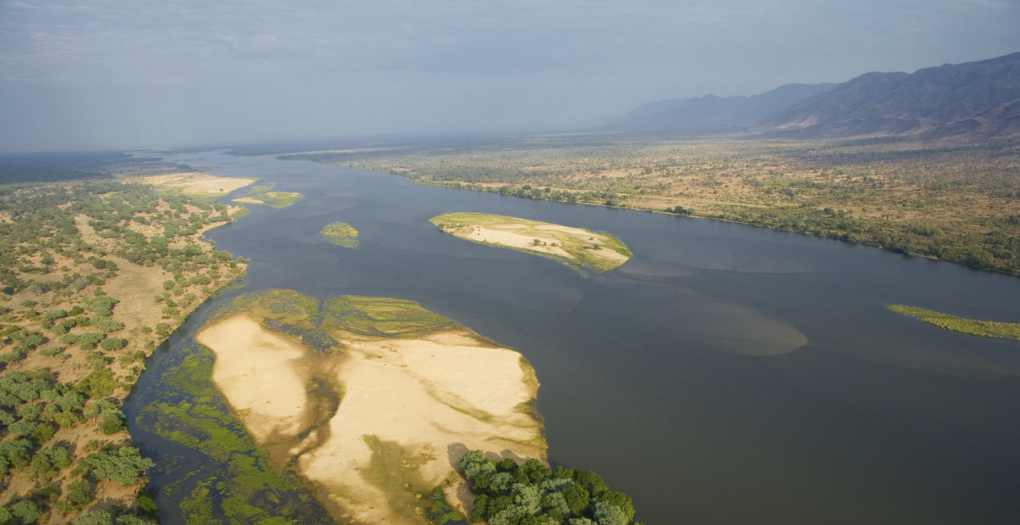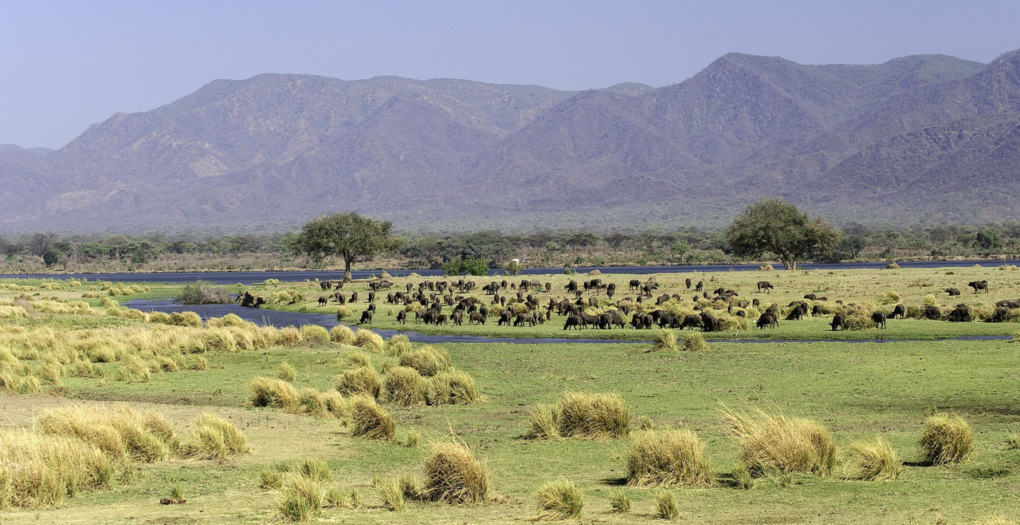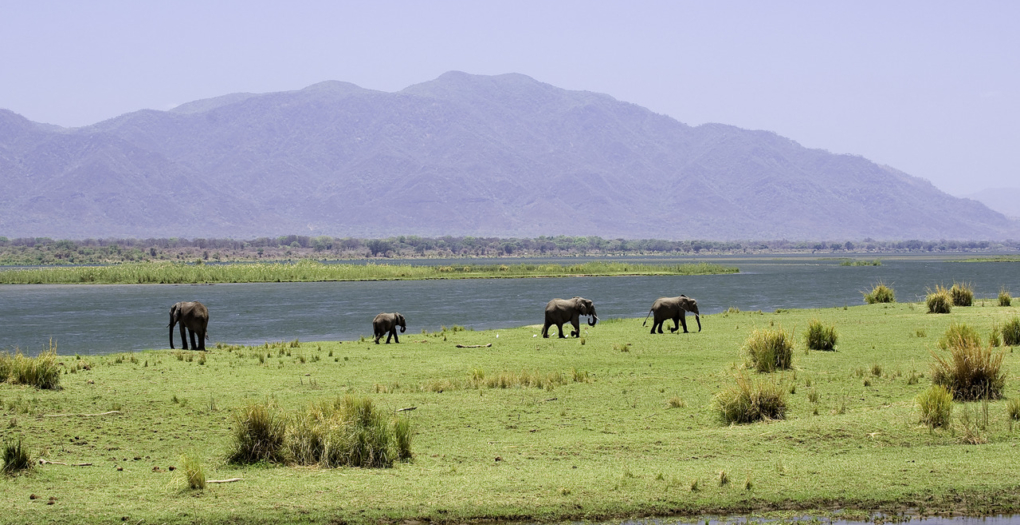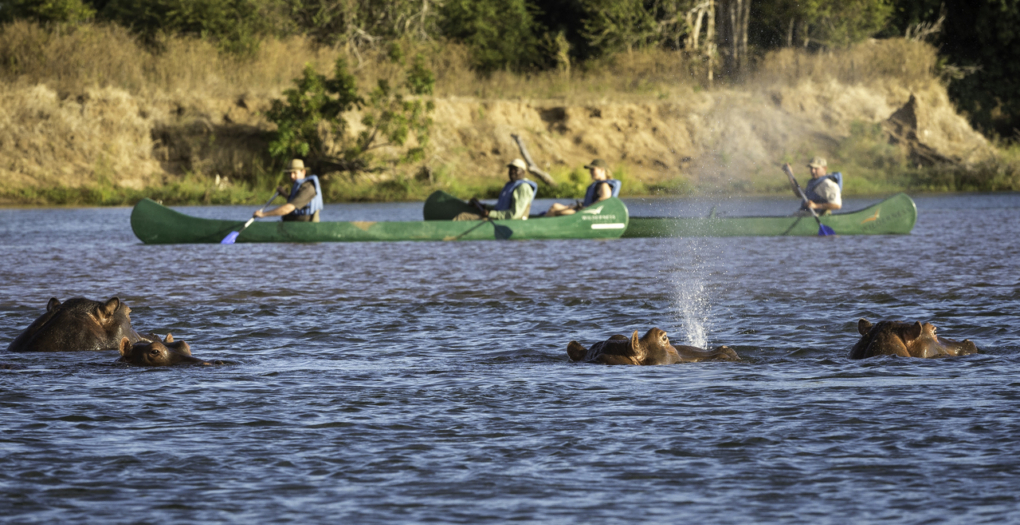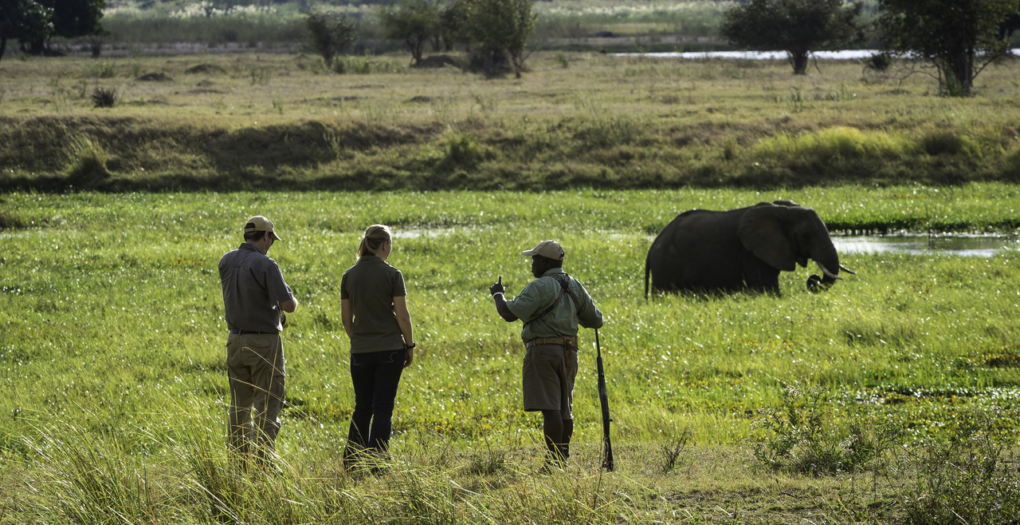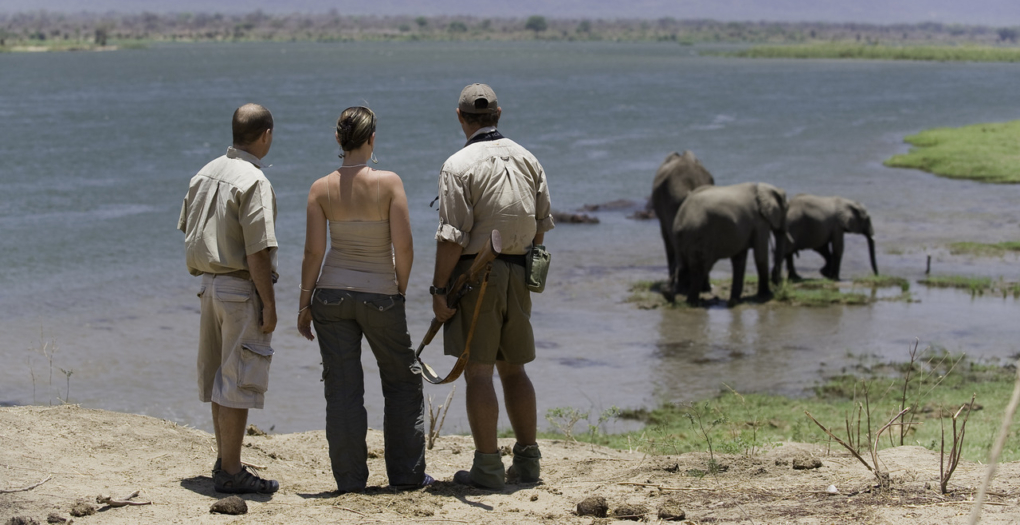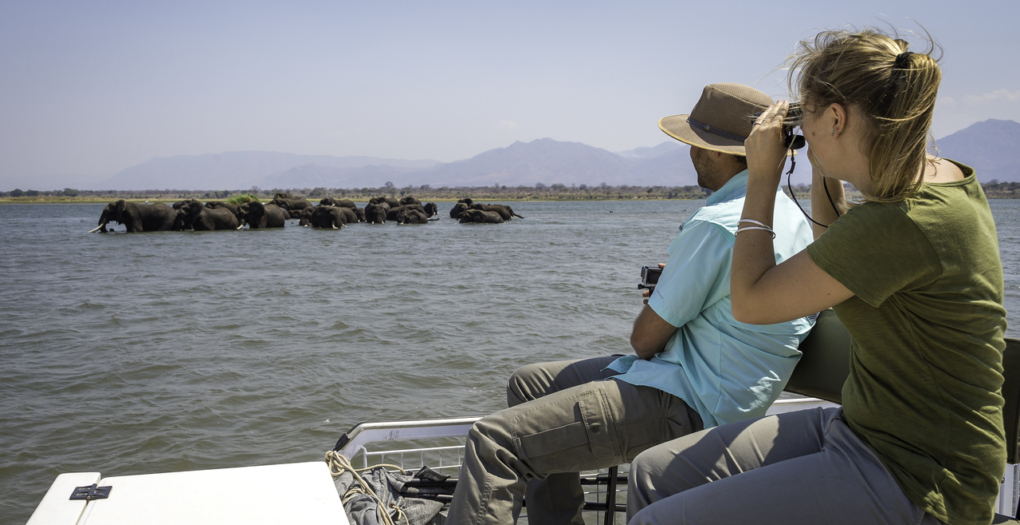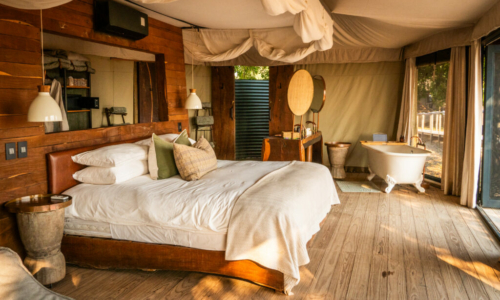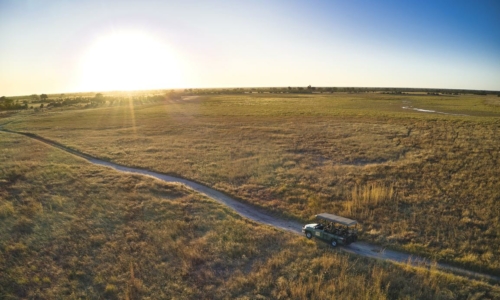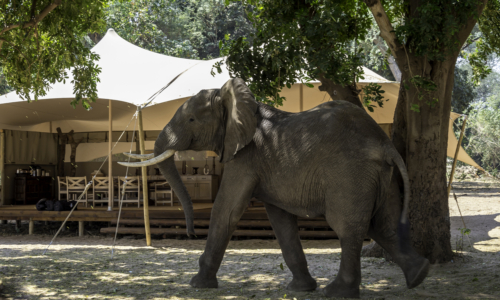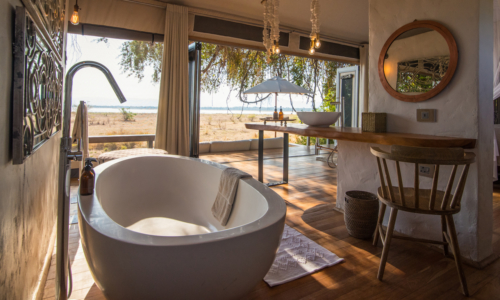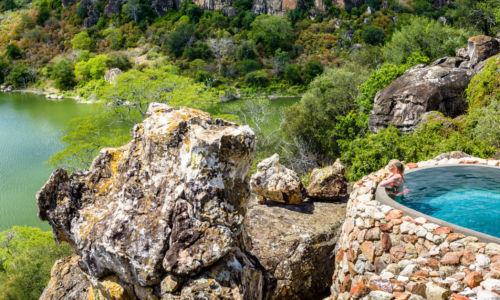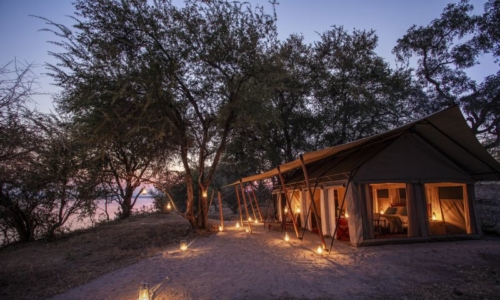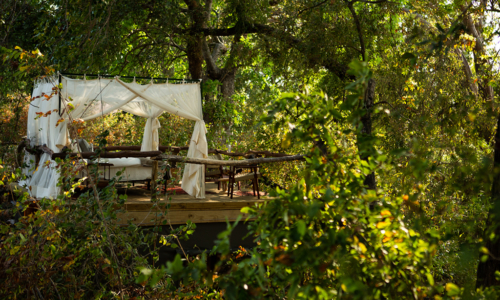Mana Pool National Park is a UNESCO World Heritage Site that comprises 1,367 square miles in northern Zimbabwe. It is situated in the lower Zambezi River area where the flood plains are transformed into broad stretches of lakes after the rainy season. Once the lakes dry up and recede, it draws an abundance of wildlife in search of water making it a prime game-viewing area. Mana means fours in the local Shona language which is a reference to the four permanent pools formed by the middle Zambezi. The diverse ecosystem is made up of riverbanks, islands, sandbanks and pools all bordered by forests of mahogany, ebonies, wild figs, and baobab trees.
While there is a wide diversity of animals found in the Park, it is renowned for its large populations of hippos, crocodiles, and large mammals such as zebra, elephant, and Cape buffalo. In fact, the Park has so many bull elephants that return to the area year after year that several guides have gotten to know some of the individual elephants allowing the guides to approach them closely on foot. It is also home to many threatened predators including lions, cheetahs, Cape wild dog, and the near-threatened leopard and brown hyena.
Unfortunately, the Park used to be an important refugee for the black rhinos and had 500 animals at one time, but poaching had reduced the number to just ten by 1994. So, these ten were removed to another area to ensure their protection. Mana Pools is a great place for birdwatchers with over 380 recorded species. The best time for bird watching is in April at the end of the rainy season when storks, herons, cormorants, darter, and fish eagles can be spotted.
With both a diverse ecology and the Zambezi River forming the northern border of Mana Pools, there is a wide range of land-based and water-based activities to enjoy here. Most of the nearby safari lodges and camps have game drives conducted by expert guides and trackers in 4×4 vehicles. Walking safaris are the best way to really learn about the local flora and fauna with the knowledgeable assistance of a scout. Half-day, full-day, and even multiple day canoeing trips are available for exploring the Zambezi River. Anglers will love catch and release fishing of several species including tilapia and tiger fish. More importantly, Mana Pools National Park has less human traffic than a lot of other parks and has an uncrowded and wilder feel to it.


- Amalinda Lodge
- Bumi Hills Safari Lodge
- Camp Hwange
- Changa Safari Camp
- Chikwenya
- Davison’s Camp
- Deteema Springs
- Ingwe Pan
- Kanga Camp
- Linkwasha Camp
- Little Makalolo
- Little Ruckomechi
- Little Vundu
- Mana River Camp
- Matetsi Victoria Falls
- Mpala Jena Camp
- Nyamatusi Camp
- Nyamatusi Mahogany
- Old Drift Lodge
- Pamushana Lodge
- Ruckomechi Camp
- Sapi Explorers Camp
- Sapi Springs Camp
- Somalisa Acacia
- Somalisa Camp
- Somalisa Expeditions
- Tembo Plains
- The Elephant Camp
- The Hide
- Verney’s Camp
- Vundu Camp
- Zambezi Expeditions
- Amalinda Lodge
- Bumi Hills Safari Lodge
- Camp Hwange
- Changa Safari Camp
- Chikwenya
- Davison’s Camp
- Deteema Springs
- Ingwe Pan
- Kanga Camp
- Linkwasha Camp
- Little Makalolo
- Little Ruckomechi
- Little Vundu
- Mana River Camp
- Matetsi Victoria Falls
- Mpala Jena Camp
- Nyamatusi Camp
- Nyamatusi Mahogany
- Old Drift Lodge
- Pamushana Lodge
- Ruckomechi Camp
- Sapi Explorers Camp
- Sapi Springs Camp
- Somalisa Acacia
- Somalisa Camp
- Somalisa Expeditions
- Tembo Plains
- The Elephant Camp
- The Hide
- Verney’s Camp
- Vundu Camp
- Zambezi Expeditions

Mana Pool National Park is a UNESCO World Heritage Site that comprises 1,367 square miles in northern Zimbabwe. It is situated in the lower Zambezi River area where the flood plains are transformed into broad stretches of lakes after the rainy season. Once the lakes dry up and recede, it draws an abundance of wildlife in search of water making it a prime game-viewing area. Mana means fours in the local Shona language which is a reference to the four permanent pools formed by the middle Zambezi. The diverse ecosystem is made up of riverbanks, islands, sandbanks and pools all bordered by forests of mahogany, ebonies, wild figs, and baobab trees.
While there is a wide diversity of animals found in the Park, it is renowned for its large populations of hippos, crocodiles, and large mammals such as zebra, elephant, and Cape buffalo. In fact, the Park has so many bull elephants that return to the area year after year that several guides have gotten to know some of the individual elephants allowing the guides to approach them closely on foot. It is also home to many threatened predators including lions, cheetahs, Cape wild dog, and the near-threatened leopard and brown hyena.
Unfortunately, the Park used to be an important refugee for the black rhinos and had 500 animals at one time, but poaching had reduced the number to just ten by 1994. So, these ten were removed to another area to ensure their protection. Mana Pools is a great place for birdwatchers with over 380 recorded species. The best time for bird watching is in April at the end of the rainy season when storks, herons, cormorants, darter, and fish eagles can be spotted.
With both a diverse ecology and the Zambezi River forming the northern border of Mana Pools, there is a wide range of land-based and water-based activities to enjoy here. Most of the nearby safari lodges and camps have game drives conducted by expert guides and trackers in 4×4 vehicles. Walking safaris are the best way to really learn about the local flora and fauna with the knowledgeable assistance of a scout. Half-day, full-day, and even multiple day canoeing trips are available for exploring the Zambezi River. Anglers will love catch and release fishing of several species including tilapia and tiger fish. More importantly, Mana Pools National Park has less human traffic than a lot of other parks and has an uncrowded and wilder feel to it.

- Amalinda Lodge
- Bumi Hills Safari Lodge
- Camp Hwange
- Changa Safari Camp
- Chikwenya
- Davison’s Camp
- Deteema Springs
- Ingwe Pan
- Kanga Camp
- Linkwasha Camp
- Little Makalolo
- Little Ruckomechi
- Little Vundu
- Mana River Camp
- Matetsi Victoria Falls
- Mpala Jena Camp
- Nyamatusi Camp
- Nyamatusi Mahogany
- Old Drift Lodge
- Pamushana Lodge
- Ruckomechi Camp
- Sapi Explorers Camp
- Sapi Springs Camp
- Somalisa Acacia
- Somalisa Camp
- Somalisa Expeditions
- Tembo Plains
- The Elephant Camp
- The Hide
- Verney’s Camp
- Vundu Camp
- Zambezi Expeditions
- Amalinda Lodge
- Bumi Hills Safari Lodge
- Camp Hwange
- Changa Safari Camp
- Chikwenya
- Davison’s Camp
- Deteema Springs
- Ingwe Pan
- Kanga Camp
- Linkwasha Camp
- Little Makalolo
- Little Ruckomechi
- Little Vundu
- Mana River Camp
- Matetsi Victoria Falls
- Mpala Jena Camp
- Nyamatusi Camp
- Nyamatusi Mahogany
- Old Drift Lodge
- Pamushana Lodge
- Ruckomechi Camp
- Sapi Explorers Camp
- Sapi Springs Camp
- Somalisa Acacia
- Somalisa Camp
- Somalisa Expeditions
- Tembo Plains
- The Elephant Camp
- The Hide
- Verney’s Camp
- Vundu Camp
- Zambezi Expeditions






 Safari Camps
Safari Camps Points of Interest
Points of Interest Hotels & Resorts
Hotels & Resorts  Journeys
Journeys

